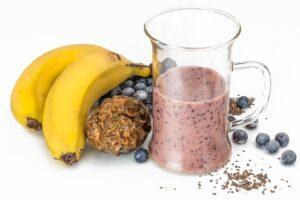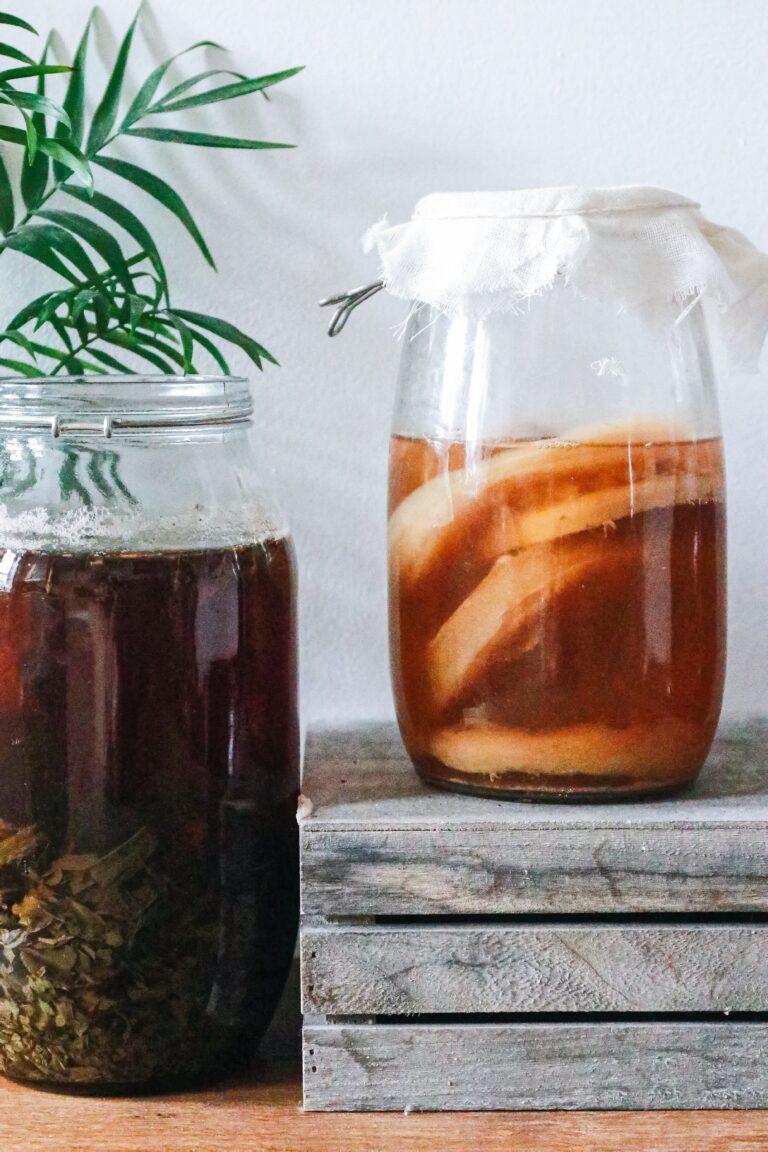Probiotic Smoothies
Probiotic smoothies are a fantastic, creative way of getting the good bacteria, and squeezing several servings of produce into your day’s diet. If you are a picky eater like me, your imagination shouldn’t stop at sauerkraut, homemade kimchi, or unsweetened yogurt for boosting your body’s beneficial bacteria population.
Making a probiotic smoothie is a no brainer. It is a tad easier if you already have a smoothie recipe to die for. If you have never made a smoothie for yourself and have no idea what goes into one, you are in the right place. You can sample any of the recipes in this guide or follow the ingredients criteria guide in the end to pick healthful, probiotic smoothie foods that appeal to your palette.

The Best Probiotic Foods to Add to a ‘Probiotic’ Smoothie
The richest and most common probiotic foods include:
Kefir
Kefir is the most popular probiotic food in the natural health community. It is high in nutrient and probiotics with numerous benefits for gut health. Traditionally, kefir is made by adding kefir grains to cow or goat milk. Kefir grains look like cauliflower. They are not grains per se, but lactic acid bacteria and yeast colonies that look like grains.
According to healthline, one cup of low-fat kefir contains;
Calories: 104
Carbs: 11.6
Fat: 2-3 grams
Protein: 9 grams
You will also get over 20% of daily calcium, phosphorus, vitamin B12, and Riboflavin needs. Best of all, if you are lactose intolerant, you will have an easier time digesting kefir as the lactic acid bacteria added to the milk ferments the lactose.
Kefir Smoothie Recipe
Ingredients
- ½ cup plain kefir
- 1 banana
- ½ cup pumpkin puree
- ½ teaspoon pumpkin-pie spice
- ¼ teaspoon cinnamon
- Ice
Directions
- Make the pumpkin puree by halving a fresh sugar pumpkin and baking in a preheated oven for 1 hour, or until tender.
- Scrape the pumpkin flesh from the shells and puree in a blender.
- Get ½ cup of the puree and store the rest in the fridge.
- Put all the ingredients in a blender and blend until smooth.
- Serve and enjoy.
Yogurt (Dairy or non-dairy)
You can add dairy or non-dairy yogurt to your probiotic smoothies and get the recommended probiotic supply. Yogurt has a ton of health benefits and is highly recommended for improving symptoms of various gastrointestinal tract issues. Since it is pre-digested people with lactose intolerance can take yogurt.
When choosing dairy yogurt for your probiotic smoothies, avoid the low-fat, high-sugar, and flavored brands. Unsweetened brands are the better option because plain yogurt is more nutritious. Plus, there are plenty of natural ways to add sweetness to your smoothie, including; dates, fresh fruits, and a drizzle of honey.
100 grams of plain whole milk yogurt contains:
Calories: 61
Protein: 3.5 g
Fat: 3.3 g
Carbs: 4.7 g
Sugar: 4.7 g
Water: 88%
If you are allergic to dairy, you can opt for non-dairy yogurt. Coconut yogurt is the most common and readily available non-dairy yogurt in the market. Like dairy yogurt, coconut yogurt has plenty of gut-friendly bacteria and dietary fiber that is beneficial to your gut health. You may miss on the high protein content in dairy yogurt, but gain from the medium-chain fatty acids in coconut yogurt. The fat will fill you up. According to USDA’s FoodData Central, 100 grams of coconut meat has only 3 grams of protein and 33.5 grams of fat. Protein powder and chia seeds can make up for the protein content you miss from coconut yogurt.
Dairy Yogurt Smoothie Recipe (Raspberry-Almond)
Ingredients
- ¾ cup plain yogurt
- ½ cup raspberries
- 1 tablespoon almond butter
- ½ tablespoon chia seeds
- Ice
Directions
- Add all the ingredients to a blender and blend till smooth and well mixed.
Non-dairy Yogurt Smoothie Recipe (Coconut yogurt-berries)
Ingredients
- 1 cup of coconut yogurt
- 2 cups of mixed berries
- ½ tablespoon raw honey
- Ice
Directions
- Combine all the ingredients in a high-speed blender and puree until smooth. Stop and scrape the blender’s sides as needed.
- If you are using frozen berries, remove them from the freezer and allow them to thaw before blending.
- You can add organic food-grade lavender buds to enhance the smoothie’s flavor.
Kimchi
Kimchi is a popular Korean fermented vegetable dish, highly recommended by food experts as a rich source of probiotics. The most popular kimchi; (baechu-kimchi) is made with napa cabbage. Other Kimchi varieties have ingredients like pumpkin and cucumber.
Of all the fermented foods on this guide, Kimchi is the only option with a spicy kick; typical of Korean cuisine. The spiciness makes it the perfect ingredient for a savory green smoothie. From a one-cup serving of Kimchi you will get:
Calories: 23
Fat: less than 1 gram
Protein: 1 gram
Carbohydrates: 4 grams
Fiber: 2 grams
Besides being an excellent probiotic, Kimchi is also a great source of Vitamins A, C, and K, and minerals like Potassium and Calcium.
Savory Green Kimchi Smoothie Recipe
Ingredients
- 2 tablespoons of Kimchi
- Fresh coriander sprig
- ½ cucumber
- ½ medium-sized melon
- ½ lime squeezed juice
- Lime slices
- Ice
- 2 tablespoons extra-virgin oil
- Salt
- Black pepper
Directions
- Put all the ingredients except olive oil, salt and black pepper. Blend to a puree.
- While the motor is still running, add the extra-virgin olive oil.
- Season with salt and pepper.
- Adjust the ingredients to achieve a perfect balance of sweetness, saltiness, spiciness, and acidity. You can add maple syrup or honey if the melon is not sweet enough.
- Garnish with the lime slices and serve.
Kombucha
Kombucha is fermented tea famed for preventing numerous health issues including Cancer, hair loss and AIDS. Although there is no scientific proof of its disease preventing powers, everyone could use some of the drink’s beneficial elements.
You can make kombucha from home as its ingredients are pretty basic. All you need is yeast, sugar, and black tea. You can set the mixture aside for a week or longer for fermentation to occur. During fermentation, bacteria, acids and a bit of alcohol form. The bacteria and acids form a symbiotic colony of bacteria and yeast (SCOBY), which appears as a film on top of the tea. You can use the scoby to make more Kombucha.
The bacteria in kombucha is the gut-friendly, lactic-acid bacteria. In addition, you get a healthy dose of Vitamin B from the drink. Here is a Kombucha smoothie recipe packed with probiotics and prebiotics.
Kombucha Banana-Raspberry Smoothie Recipe
Ingredients
- ½ cup raspberry
- ½ cup Kombucha
- 1 banana
- 1 tablespoon chia seeds
- 1 tablespoon rolled oats
- 1 tablespoon almond butter
- 1 cup oat milk
Directions
- If you are using frozen raspberries, remove from the freezer and thaw.
- Put the raspberries in a bowl and mash with a fork.
- Add chia seeds to the bowl with raspberries and mix.
- Set aside for 10 minutes, to form a raspberry chia jelly.
- Add the remaining ingredients to a blender and blend to get a smooth, creamy liquid.
- Put half of the raspberry chia jelly into a serving glass then pour the kombucha mixture over it.
- Mix with a spoon and serve.

How to Choose Probiotic Smoothie Ingredients
You could easily grab a probiotic food in your local grocery store or make one from home. The process of making probiotics is not too complicated as it merely involves the addition of microbes to food, so it can ferment. Some key aspects to consider when choosing a probiotic smoothie’s ingredients are:
Live active cultures
When shopping for probiotic foods, be sure to check for live active cultures. They are an indication that the bacteria in the food are still living and will be beneficial to you. For example, if you need probiotic sauerkraut to add to your veggie smoothie, refrigerated brands with live culture are your best bet. Shelf-stable brands in a can or jar; the kind you use as a hotdog condiment at barbecue parties are unlikely to have live, active cultures.
Prebiotic foods
When making a probiotic smoothie, consider using prebiotic foods as the main ingredients for more gut health benefits. The microbes in probiotic foods join the community of health-promoting microorganisms in your gut. Prebiotic foods keep these microorganisms alive.
According to a Forbes Health article, prebiotic foods are nutrient-dense foods that contain crucial types of soluble dietary fiber. Think of them as fuel for the good bacteria that keep your gut in balance. Bananas, asparagus, and oats are top prebiotic food options that you can add to a probiotic smoothie.
A banana and kefir smoothie, or yogurt with blueberries smoothie are perfect combinations of prebiotic and probiotic foods. Adding high-fiber ingredients like whole grains, nuts, seeds, vegetables, fruits and legumes to the smoothie will make it even better for your gut.
Anti-inflammatory foods
Anti-inflammatory foods like berries, grapes, broccoli, flax seeds, and walnuts are also excellent ingredients for a probiotic smoothie. They contain nutrients that act as natural antioxidants and help cool down inflammation, thus promoting gut health.
Natural sweeteners
The last thing you want to do is ruin an uber-healthful glass of probiotic smoothie with artificial flavors and sugar. Use natural sweeteners like sweet fresh fruits, natural raw honey, dates, or sugarcane juice.
Probiotic Smoothie – Final Thoughts
We all need a variable nutrient-dense diet to maintain a healthy gut microbiome. A probiotic smoothie is the easiest way of getting all the gut-friendly bacteria and nutrients all at once. All the probiotic and prebiotic foods suggested in the guide will improve your digestion, boost your energy and rid your body of all toxins. A glass of probiotic smoothie twice of thrice a week may ward off chronic illnesses like high blood pressure, cancer and heart disease.
Comments are closed.